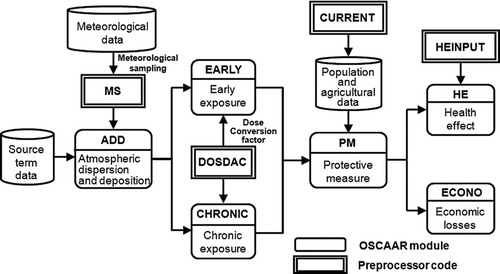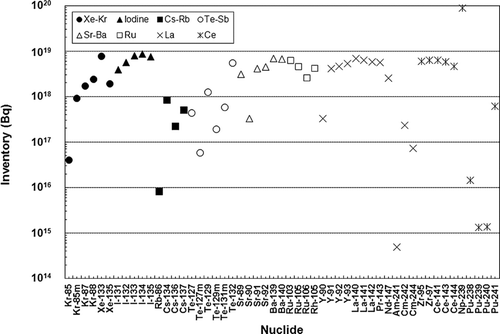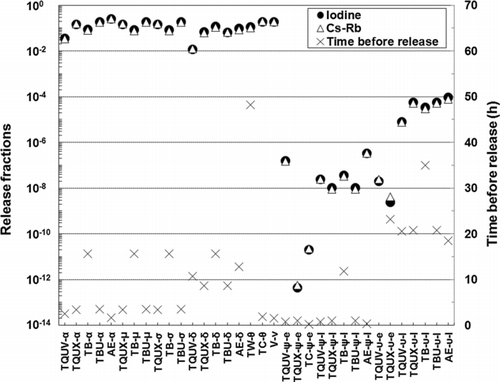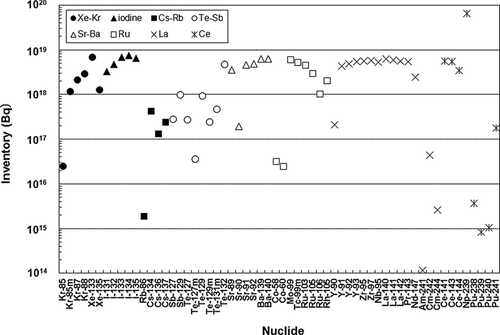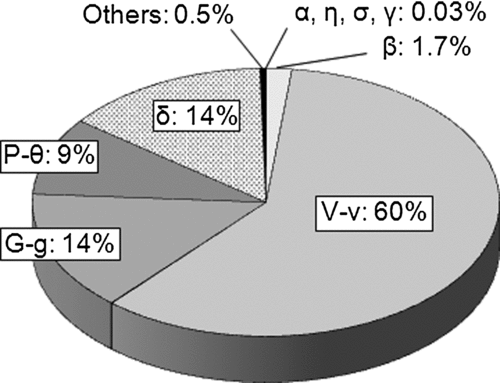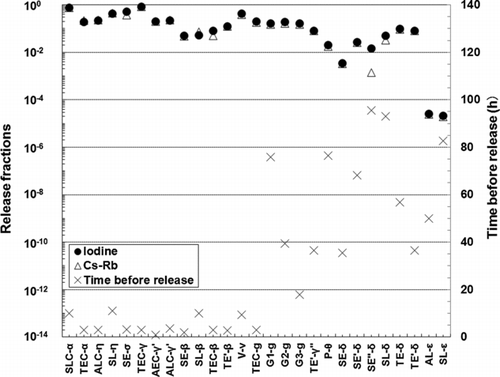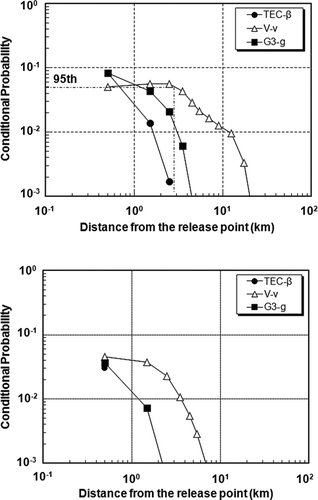Abstract
To develop an effective emergency plan for a nuclear accident, the size of the precautionary action zone (PAZ) was evaluated using a Level 3 probabilistic safety analysis (PSA) code, the OSCAAR. For accident scenarios identified through a Level 2 PSA analysis for representative boiling water reactor (BWR) and pressurized water reactor (PWR) plants, the absorbed doses to red marrow were calculated as a function of the distance from the accidental site for possible weather sequences in a year, and then the evaluation was made for the distance which satisfies the dose criterion of 1 Gy for acute exposure, as established in the Basic Safety Standards (BSS) of the International Atomic Energy Agency (IAEA). Consequently, the present study indicated that the size of the PAZ should be approximately a 3-km radius under average weather conditions.
1. Introduction
When a nuclear accident results in the release of radioactive material into the atmosphere, urgent protective actions should be taken immediately to protect the public, particularly in the region around the accidental site. Therefore, arrangements must be in place for effectively making and implementing decisions regarding urgent off-site protective actions to be taken. In 2002, the International Atomic Energy Agency (IAEA) issued the safety requirements GS-R-2 [Citation1] that requires the specification of off-site emergency zones for which arrangements shall be made for taking urgent protective actions. The precautionary action zone (PAZ) is the area for which arrangements shall be made with the goal of taking precautionary urgent protective actions, before or shortly after the release of radioactive material begins, based on the conditions at a nuclear facility to substantially reduce the risk of severe deterministic health effects that are fatal or life threatening or result in a permanent injury that reduces quality of life [Citation1].
In Japan, the Nuclear Safety Commission (NSC) of Japan issued emergency preparedness guidelines [Citation2] in 1980 after the Three Mile Island Unit-2 (TMI-2) accident and then revised as needed. The guidelines outline the emergency planning zone (EPZ) that is defined by the area with a specific distance from a nuclear facility assuming situations that cannot technically occur in nuclear facilities with sufficient safety countermeasures [Citation2]. Specifically, the EPZ for a nuclear power plant is within an 8–10 km area from the site, and protective actions are required to be implemented in this area. Recently, the NSC of Japan has revised the guidelines and considered introducing the concept of precautionary urgent protective actions to improve emergency preparedness and response. Thus, the evaluation of the size of the PAZ is important for developing an effective emergency plan, including the appropriate protective actions.
To prepare adequate emergency response procedures, technical information is needed, which includes accident characteristics such as the duration of an accident, the release of radioactive material and the extent of the area potentially impacted. However, there was no specific accident that could be isolated as the one for which to plan, because each accident could have different consequences, both in nature and degree. Further, it will be necessary to consider the use of a spectrum of accidents as a basis for developing emergency response plans [Citation3]. Probabilistic safety assessment (PSA) provides a tool for the systematic and comprehensive assessment of nuclear power plant safety. A Level 3 PSA, one of the major parts of a full scope PSA, assesses the off-site consequences of potential accidental releases to the atmosphere, taking into account the range of environmental conditions at the time of the accident and the appearance probability associated with these conditions. Therefore, it is useful for evaluating the size of the PAZ based upon a comprehensive consequence assessment that considers the full range of postulated events for nuclear accidents.
In the present study, the size of the PAZ was evaluated in terms of the radiation dose using a Level 3 PSA code, the off-site consequence analysis code for atmospheric release in reactor accident (OSCAAR) [Citation4].
2. Methods
2.1. Outline of the OSCAAR
The OSCAAR is a Level 3 PSA code developed by the Japan Atomic Energy Research Institute (JAERI, formerly the Japan Atomic Energy Agency (JAEA)). It contains models for the off-site consequence of nuclear accidents, in which a plume of radioactive material is released into the atmosphere.
Figure shows the structure of the OSCAAR. This code consists of a series of interlinked modules and data files that are used to calculate the atmospheric dispersion and deposition of selected radionuclides for all sampled meteorological sequences, as well as the subsequent radiation doses and health effects to the public. The atmospheric dispersion and deposition module in the OSCAAR has a multipuff trajectory model that can consider changes in the wind direction and variable releases of long duration. Several stand-alone preprocessor codes can be used to prepare the input data, such as meteorological data, dose conversion factors, population distribution, agricultural production, and lifetime risk for the exposed population. Given information on the source terms provided by a Level 2 PSA, which takes into account key phenomena potentially challenging the containment integrity and leading a release of radioactive material to the environment, meteorological sequences, and population distribution, the OSCAAR calculates the downwind transport, airborne dispersion, and ground deposition of radioactive materials, as well as the radiation doses from cloudshine, groundshine, inhalation, and ingestion exposure pathways.
2.2. Accident scenarios and source terms
Accident scenarios used for the present study were taken from the Level 2 PSA results for internal events of representative boiling water reactor (BWR) and pressurized water reactor (PWR) plants by the Japan Nuclear Energy Safety Organization (JNES) [Citation5–7]. To evaluate the size of the PAZ, representative scenarios were selected from these accident scenarios in light of the occurrence frequency of the accident scenarios, the release fractions of iodine or cesium groups resulting in acute exposure in the early phase of the accident, and the time before release related to the implementation of the protective action. These parameters are important for evaluating radiation doses and implementing urgent protective actions in a PAZ.
The possibility of the occurrence of these accident scenarios was considerably less than the proposed performance goals of nuclear power plants for evaluating individual risk of early fatalities [Citation8]. The goals are expressed by a core damage frequency (CDF) and a containment failure frequency (CFF) of 10−4 and 10−5 per reactor-year, respectively. In the present study, accident scenarios with extremely low frequency of the occurrence were excluded from the evaluation of the PAZ. The release fraction of iodine to the initial inventory was used as a cut-off criterion for the selection of accident scenario, which was approximately 10−5 of the hypothetical accident shown by the NSC's emergency preparedness guidelines [Citation2]. The accident scenarios with the time before release less than a day were selected, considering the time needed for the completion of evacuation.
2.2.1. BWR
Possible accident scenarios were derived for a BWR-5 with a Mark II containment. The inventory of radioactive materials for the BWR plant was shown in Figure [Citation6]. These scenarios were characterized as plant damage states shown in Table [Citation9] and the following release categories identified for the postulated types of containment failures modes:
Table 1 Plant damage states for the BWR plant
| • | In-vessel steam explosion (α) | ||||
| • | Melt attack on the BWR containment liner (μ) | ||||
| • | Direct containment heating (DCH) (σ) | ||||
| • | Over-pressurization with steam and non-condensable gases (δ) | ||||
| • | Failure before core damage by over-pressurization with steam (θ) | ||||
| • | Interface-systems loss-of-coolant accident (LOCA) (ν) | ||||
| • | Accident termination in the reactor coolant system (RCS) (ψ − e) | ||||
| • | Accident termination in the containment (ψ − l) | ||||
| • | Containment vent (υ− e, υ− l) | ||||
The BWR accident scenarios were selected in light of the contributors to the CFF, as shown in Figure , and the release fractions and the time before release for the accident scenarios, as shown in Figure . In the present study, the accident scenarios with the containment failure modes of α, μ, and σ, which have a very low occurrence frequency, were excluded. Thus, the accident scenarios were selected from those with δ, θ, and ν. However, the TW − θ and TC − θ accident scenarios were also excluded because the time before release for the TW − θ is approximately 2 days, and the occurrence frequency of TC − θ is very low. As a result, the present study assessed the size of the PAZ for the following accident scenarios:
Figure 3 Contributors to the containment failure frequency for the release categories for the BWR plant
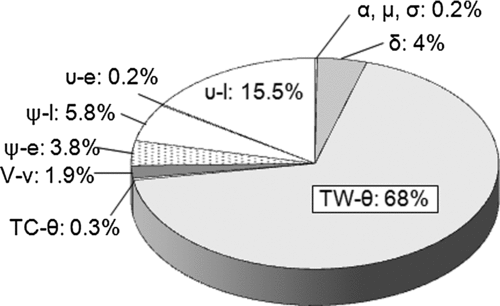
| • | Transient with loss of all emergency core cooling system (ECCS) injections (TQUV − δ) | ||||
| • | Transient with failure of depressurization of the reactor coolant system (TQUX − δ) | ||||
| • | Station blackout (TB − δ) | ||||
| • | Station blackout with failure of high pressure injection (TBU − δ) | ||||
| • | Large break LOCA with loss of all ECCS injections (AE − δ) | ||||
| • | Interface-systems LOCA (V − ν) | ||||
Table shows the details of the source terms for these accident scenarios [Citation5,6].
Table 2 Source terms for the BWR plant
2.2.2. PWR
Possible accident scenarios were derived for a PWR four-loop with a prestressed concrete containment vessel. The inventory of radioactive materials for the PWR plant was shown in Figure [Citation7]. These scenarios were characterized by the release categories depending on plant damage states shown in Table [Citation10] and the following containment failure modes:
Table 3 Plant damage states for the PWR plant
| • | Steam explosion (In-vessel (α), Ex-vessel (η)) | ||||
| • | DCH (σ) | ||||
| • | Hydrogen combustion (before reactor pressure vessel (RPV) failure (γ), at RPV failure (γ′), after RPV failure (γ″)) | ||||
| • | Containment isolation failure (β) | ||||
| • | Containment bypass (ECCS line (ν), steam generator tube rupture (SGTR) (g)) | ||||
| • | Over-pressurization (before core melt starts (θ), after core melt starts (δ)) | ||||
| • | Basemat melt-through (ɛ) | ||||
The PWR accident scenarios were selected in light of contributors to the CFF, as shown in Figure , and the release fractions and time before release, as shown in Figure . In the present study, the accident scenarios with the containment failure modes of α, η, σ, and were excluded due to a very low occurrence frequency. In addition, the accident scenarios with θ, δ, and ɛ with low release fractions or a time before release longer than a day were also excluded. In the accident scenarios with β and g those with shorter times before release and higher occurrence frequencies were selected. As a result, the present study assessed the size of the PAZ for the following accident scenarios:
| • | Containment isolation failure for transient with loss of heat removal from primary system (TEC − β) | ||||
| • | Containment bypass for interface-systems LOCA (V − ν) | ||||
| • | Containment bypass for SGTR (G3 − g) | ||||
Table shows the details of source terms for these accident scenarios (personal communication from Dr. M. Kajimoto of the JNES) [Citation7].
Table 4 Source terms for the PWR plant
2.3. Evaluation procedure
In the present study, we calculated the absorbed doses to red marrow that cause severe deterministic effects for the selected accident scenarios using the OSCAAR code because red marrow is one of the most radiosensitive tissues and loss of red marrow function leads to death [Citation11]. The exposure pathways were cloudshine, groundshine, and inhalation. The OSCAAR code adopted a polar-coordinate system. Thus, the region potentially affected by a release of radioactive materials was represented with a (r, θ) grid system centered on the release location. In addition, the representative values of absorbed doses to red marrow at each distance from the release point were selected from the maximum values for the residential region in the corresponding annulus.
The consequences of a given accident release at a given location vary with meteorological conditions. Therefore, the evaluation of the radiation dose was necessary for the possible meteorological conditions at the accidental site. In one year's worth of meteorological data, there are 8760 h, and therefore, 8760 possible weather sequences. In the present study, the absorbed dose to red marrow was calculated for all the possible weather sequences. The site of the meteorological data and the population distribution data for the Tokai site of the JAEA were used for this study, and the release height was set at 0 m. The dry deposition velocity was assumed to be 0 (m/s) for the noble gases, 5.0 × 10−4 (m/s) for organic iodine, and 1.0 × 10−3 (m/s) for other compounds [Citation12].
Next, using the results from the evaluation of the radiation doses for all the possible weather sequences, the conditional probability of a weather occurrence exceeding the dose criterion was calculated at each distance. Dose criteria of 1 and 3 Gy were applied. Finally, the probabilistic distribution of a weather occurrence exceeding the dose criteria at each distance was shown in the form of complementary cumulative distribution functions (CCDFs), and then the size of the PAZ was evaluated in light of the conditional probability for the weather occurrence.
3. Results and discussion
3.1. The CCDF of absorbed doses to red marrow in the accident scenarios
3.1.1 BWR
Figure (a) and (b) show the relationship between the distance from the release point and the conditional probability of a weather occurrence exceeding the dose criteria of 1 and 3 Gy, respectively, for the accident scenarios at a BWR plant. The magnitude of the consequence increases in the order of accident scenarios: V − ν > TB − δ > TBU − δ. The V − ν accident scenario was assumed to involve a large release of radionuclides and cause widespread consequences, and the difference in the release fractions for the δ release category contributed to the consequences. In addition, the greater the dose criterion, the shorter the distance over which the conditional probability of a weather occurrence was applicable. In the case of the V − ν accident scenario, the distance above the 50th percentile values for a weather occurrence is approximately 3 km at a dose criterion of 1 Gy (Figure (a)) and 1 km at 3 Gy (Figure (b)). Furthermore, the distance depends on the set value of the conditional probability of a weather occurrence. For example, the distance over the 95th percentile values for a weather occurrence for the V − ν accident scenario is approximately 6 km at a dose criterion of 1 Gy (Figure (a)), and 1 km at 3 Gy (Figure (b)).
3.1.2. PWR
Figure (a) and (b) show the relationship between the distance from the release point and the conditional probability of a weather occurrence exceeding the dose criteria of 1 and 3 Gy, respectively, for the accident scenarios at a PWR plant. The magnitude of the consequence increases in the order of the accident scenarios: V − ν > G3 − g > TEC − β. Similar to the case for the BWR plant, the distance depends on the level of the dose criterion and the conditional probability of a weather occurrence. However, in the case of the V − ν accident scenario, the distance over the 50th percentile value for a weather occurrence is not observed in Figure (a) and (b). In addition, the distance depends on the set value of the conditional probability of a weather occurrence. The distance over the 95th percentile values for a weather occurrence is approximately 3 km at a dose criterion of 1 Gy (Figure (a)).
3.2. Consideration of the size of the PAZ
The size of the PAZ was considered using these analysis results for the Level 3 PSA of the accident scenarios at representative BWR and PWR plants. Because the results depend on the level of the dose criterion and the conditional probability of a weather occurrence, it was necessary to determine these parameters to evaluate the PAZ. In the present study, a dose criterion for the acute exposure to the whole body (bone marrow) of 1 Gy was applied, according to the IAEA's 1996 Basic Safety Standards (BSS) [Citation13]. At this dose level, protective actions can be justified under almost any circumstances. The IAEA has suggested that the size of the PAZ be assessed on the basis of calculations for average meteorological conditions [Citation14]. Therefore, the present study assessed the size of the PAZ using the 50th percentile values for a weather occurrence. Considering low occurrence frequency of the selected accident scenarios and the previously described procedure for selecting the maximum radiation doses in all directions as the representative value at each distance, it is anticipated that the size of the PAZ is conservatively evaluated. Using the results of conditional probability of a weather occurrence exceeding a dose criterion of 1 Gy shown in Figures (a) and (a), the maximum size of the PAZ was assessed at approximately a radius of 3 km for the V − ν BWR accident scenario of BWR. The PWR accident scenarios did not meet the conditions. The results of these accident scenarios represent a comprehensive assessment that considers the full range of postulated events for nuclear accidents of representative BWR and PWR plants.
4. Conclusion
The size of the PAZ was evaluated using a PSA methodology. The radiation doses to red marrow were calculated as a function of the distance from the accidental site for the possible weather occurrences in a year using the OSCAAR code with the source terms for the selected accident scenarios of the representative BWR and PWR plants. Consequently, the size of the PAZ was assessed at approximately a 3 km radius under average weather conditions using the IAEA's BSS dose criterion for acute exposure. It was found that the evaluation result was similar to the IAEA's suggested PAZ of 3–5 km [Citation14]. However, the size of the PAZ depends on the set value for the conditional probability of a weather occurrence. In the present study, the size of the PAZ was evaluated to be the range of 0.5–15 km for a BWR plant and 0.5–20 km for the PWR using a dose criterion of 1 Gy. It will be necessary to suggest the size of the PAZ based on the conditional probability of a weather occurrence, which is acceptable for emergency preparedness and response. In addition, since the source terms for BWR and PWR plants including the release fractions of radioactive materials and its timing have large uncertainties [Citation15], it is supposed that the propagation of the source term uncertainties into the off-site consequences is an important remaining issue to be clarified.
In the present study, to obtain technical knowledge for planning emergency response procedures for a nuclear accident, the size of the PAZ was evaluated, as the first step, for accident scenarios initiated by internal events such as component failures. It is noted that lessons learnt from the accident at the Fukushima Daiichi nuclear power plant show the importance of the evaluation for the adequate size of the PAZ, considering the feasibility of urgent protective actions in a complex disaster with natural hazards and a nuclear accident. Thus, it is considered that the present study is needed to be extended to situations of accidents initiated by external events such as earthquake and tsunami.
Acknowledgements
This work was supported by the Nuclear Safety Commission (NSC) of Japan. We appreciate Dr. M. Kajimoto of the JNES for providing technical advice on the analysis information.
References
- 2002 . Preparedness and response for a nuclear or radiological emergency , Vienna : IAEA . Safety Standards Series No. GS-R-2
- The emergency preparedness guidelines “Emergency preparedness of nuclear installations”. Tokyo: the NSC of Japan Japanese
- Planning basis for the development of state and local government radiological emergency response plans in support of light water nuclear power plants Washington , D.C. NUREG-0396, EPA-520/1-78/016: USNRC;
- Homma , T , Tomita , K and Hato , S . 2005 . Uncertainty and sensitivity studies with the probabilistic accident consequence assessment code OSCAAR . Nucl Eng Technol , 37 ( 3 ) : 245 – 258 .
- 2003 . Evaluation of a level 2 PSA for BWRs in Japan , Tokyo : NUPEC . INS/M03-22 Japanese
- 2005 . A level 3 PSA for internal events of BWRs , Tokyo : JNES . JNES/SAE05-003 Japanese
- 2005 . A level 3 PSA for internal events of PWRs , Tokyo : JNES . JNES/SAE05-008 Japanese
- Report on performance goals for nuclear power plant , Tokyo: the NSC of Japan . Japanese
- Kajimoto , M , Sugawara , M , Sumida , S , Funayama , K , Kasahara , F , Tanaka , N and Hirano , M . 2001 . Evaluation of technological appropriateness of the implemented accident management measures for BWR by level 1 and level 2 PSA methods Paul Scherrer Institut, PSI-Villigen , Switzerland : Proceedings of the Workshop on Implementation of severe accident management measures; 2001 Sep 10–13 .
- Kawabata , O and Kajimoto , M . “ Uncertainty analysis on containment failure frequency for a Japanese PWR plant ” . In Workshop on evaluation of uncertainties in relation to severe accidents and level 2 probabilistic safety analysis November 7–9; Hotel Aquabella, Aix-en-Provence
- 1990 Recommendations of the International Commission on Radiological Protection , Oxford: Pergamon Press . ICRP Publication 60, Ann. ICRP 21 (1-3)
- Probabilistic accident consequence assessment codes , Second international comparison . Paris: OECD-NEA;. Technical report EUR-15109
- Jointly sponsored by FAO, IAEA, ILO, OECD/NEA, PAHO, WHO, IAEA Safety Series No. 115 . 1996 . Vienna : IAEA .
- Safety Standards Series No. GS-G-2.1 . 2007 . Arrangements for preparedness for a nuclear or radiological emergency , Vienna : IAEA .
- Ishikawa , J , Muramatsu , K and Watanabe , N . 2006 . Uncertainty evaluation of source terms under severe accident conditions at LWRs . Trans Atom Energy Soc Japan , 5 ( 4 ) : 305 – 315 . Japanese
